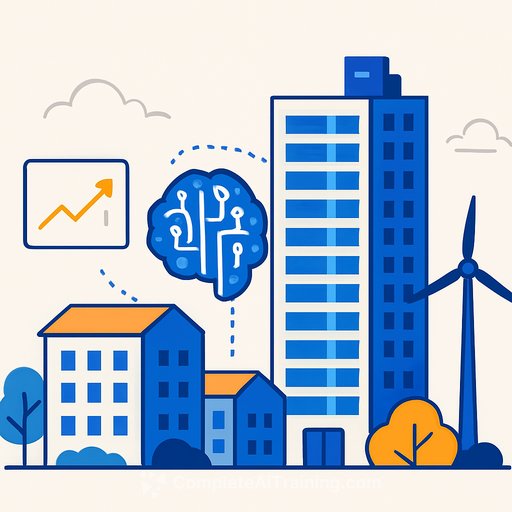Israel's hidden server boom: AI is driving a race for mega-facilities
Under a new Osher Ad store in Kfar Saba sits a concrete bunker built for compute. Multiple secured doors, guards, and reinforced systems protect 12,500 square meters of Tier III infrastructure engineered for 16 megawatts. The developer, Serverz (a partnership between Kardan Geva and Rani Zim), built a data center where most people expect retail. That's the market signal: data is taking priority over square meters of storefront.
Demand math: more heat, more megawatts
Israel had around 10 server farms in 2020. Today, 18 operate and 27 more are planned. By 2030, investments are expected to reach $1.39 billion with double-digit annual growth, while sector electricity demand has jumped from roughly 40 megawatts in 2020 to about 200 megawatts now.
The driver is AI. A typical server unit that drew 10 kW now wants 40 kW because accelerators run hotter and denser. Data centers already consume about 2% of global electricity, and AI inference and training will keep pushing that number upward. IEA data backs the trend.
Why developers are piling in
Housing sales are slow, financing is tight, and office demand is soft. Data centers, by contrast, can produce high double-digit returns if executed correctly. That's why you're seeing Mivne, Ashtrom, Amram Avraham, Azrieli, RAD-Bynet, Papouchado, and others reposition capital into this category.
Case in point: Azrieli's NIS 2.8 billion acquisition of Norwegian operator Green Mountain (2019). By 2024, analysts expected data centers to account for roughly a quarter of the company's activity. The money follows long leases, sticky tenants, and infrastructure moats.
The catch: land, grid, and approvals
Not every parcel works. You need footprint, fiber, and guaranteed power. Finding even 50 dunams in the center with both electricity and communications access has proven difficult, and in some areas (like Shoham's industrial zone) a single dunam can cost NIS 7-8 million.
Even with land secured, the critical path runs through Israel Electric Corporation. Unlike the U.S. or UAE, Israel hasn't designated data centers as strategic infrastructure, so grid connections aren't prioritized. Without a committed power delivery timeline, your schedule and returns drift.
Capex, timeline, and what actually costs money
Budget NIS 500 million+ per site and a 6-7 year development cycle. Most costs aren't the box; they're the systems-cooling, electrical, fire suppression, redundant lines, security, and cyber. Roughly 70% of a data center's energy goes to the servers; efficiency improvements, even in the 20-30% range, are material to NOI.
- Spec to Tier III at minimum for availability; many anchor tenants expect it. See Uptime Institute Tier standards.
- Plan for high-density rooms (liquid-ready) as AI racks push 30-80 kW/rack.
- Design modular power and cooling so you can phase capex as tenants scale.
- Expect PV integration pressure over time; onsite generation or PPAs will help hedge operating costs.
Two models, two risk profiles
Anchor build: one large tenant on a long lease. Lower risk, easier financing, predictable cash flow. Downsides: lower yield and higher customization.
Colocation: multi-tenant with flexible capacity. Higher yield potential and faster lease-up in a balanced market. Downsides: higher operating complexity and SLA exposure-because the standard here is zero downtime.
Supply risk is real
There are only so many Microsoft, Amazon, Google, Oracle, or Meta-scale clients. Overbuilding is a risk because capex is heavy and refresh cycles keep coming. Anyone entering this sector needs a live view of signed PPAs, grid queue positions, tenant pipelines, and competitor builds.
Site checklist for real estate and construction teams
- Power: secure committed megawatts, not just indicative letters. Validate substation timelines and redundancies.
- Fiber: dual diverse paths from separate carriers; document route separation.
- Zoning and permits: confirm data center use, noise envelopes, backup generator allowances, and fuel storage limits.
- Cooling: design for high-density AI loads; consider liquid cooling corridors even if you start with air.
- Security: layered physical security, SOC integration, and clear visitor workflows.
- Scalability: phased construction with clear swing space for fit-outs and expansions.
Financing and returns: what lenders will ask
- Anchor vs. colo mix, lease terms, and SLA liabilities.
- Interconnection agreements, EPC experience, and commissioning plan.
- Grid connection schedule and penalties for delays.
- Energy efficiency metrics and mitigation (waste-heat recovery, free cooling, renewables strategy).
Construction notes from the field
- Sequence for lead times: switchgear, generators, chillers, UPS, transformers. Lock these early.
- Commissioning is a project in itself. Budget time for integrated systems testing under load.
- Standardize rooms and corridors; it accelerates builds and eases operations.
- Document everything. Your O&M team inherits what you leave them.
The bottom line
AI demand is reshaping where capital flows and what gets built. The winners will be teams that control land with fiber and power, can deliver Tier III+ on schedule, and keep a tight grip on operating efficiency. Everyone else will watch from the sidelines as megawatts, not square meters, decide who captures the cash flow.
Your membership also unlocks:






